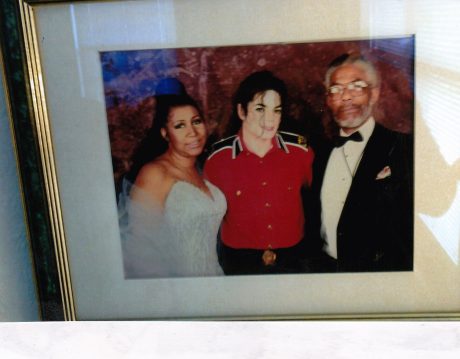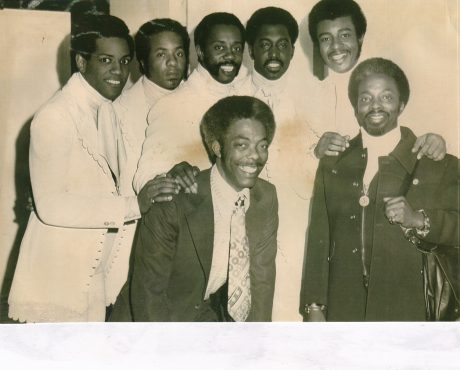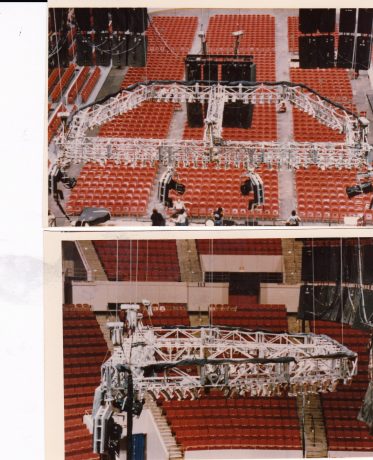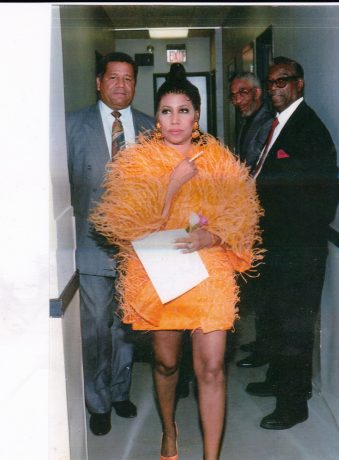
One evening back in 1961, briefcase in hand, Joe Schaffner and Earl Brooks ambled up the stairs of the Royal Peacock in Atlanta. After a week of performances by their boss and early Motown singer Marv Johnson, it was time for Schaffner and Brooks to collect the money. “There were certain rules back then.” Schaffner explains. “You didn’t dine, you didn’t drink, you didn’t do anything that required you to sign a tab. This was so that at the end of the week, they couldn’t present you with all these bills.”
Well, that’s exactly what happened in club owner Henry Wynn’s office anyway. Schaffner responded by opening the briefcase to reveal his pistol. Out of the shadows, a bodyguard appeared, drawing one too. Conversations ensued with Wynn finally relenting saying, “I’ll let it go this time.” The correct amount of cash went into the briefcase, but Schaffner hung onto his pistol.
He and Brooks then hurried down the back stairs leading to the alleyway. Once out the door, a local hood was waiting in the shadows and promptly snatched the briefcase and made a run for it. Brooks grabbed the pistol and shot the hood in the back leg. The two picked up the briefcase and never looked back.
“It was a gangster life,” Schaffner sighs, shaking his head. “You had to be aware of your surroundings.” His career would continue working with acts including the Supremes, the O’Jays, the Jackson Five, Prince, and bookending it all was Aretha Franklin. While he would eventually not feel the need to pack heat, he learned an important lesson: take care of the artist, no matter what.
And there were many other lessons the self-taught live event pioneer would learn – and pass on to scores of others. “He’s one of those guys I respect a lot,” says Lance “K.C.” Jackson, who worked with him and went on to have an impressive touring career himself that continues to this day. “Joe’s done it all from driving to designing lights to production manager. Any time his name comes up with any group of people, he’s spoken of highly. He was definitely a mentor. He would make you be cool and calm.”
Schaffner did it all: Lighting Designer, Stage Designer, Road Manager, Personal Manager, General Manager, Stage Manager, Production Manager, Entertainment Consultant, and Accountant. Along the way he’s also worked on multi-media shows for clients including Chrysler, the French Government in Paris, and the Dutch Government in Amsterdam.

Born in and of Motown
Schaffner was born in Detroit in a neighborhood that consisted of postal workers, police officers, and also … well, let’s just say “colorful characters.” “A Mr. Turner was one of the classic guys in the neighborhood who taught us kids the importance of dressing immaculately and also how to deal cards.” The neighborhood was rich with talent: There was Melvin Franklin, who would go on to be a founding member of the Temptations and Barrett Strong, who was one of the first artists Berry Gordy signed. In 1960, Gordy released Strong’s “Money (That’s What I Want)” which went to number two on the R&B chart. “He asked me to go on the road with him that summer,” Schaffner says. They did 15 shows, most memorably at the historic Howard Theatre in Washington D.C.
Oh, and the old neighborhood also included the future Queen of Soul, Aretha Franklin. “In the early days, she was going out as a gospel singer with her father and I’d tour with them. I’d do whatever was necessary to get the group on the stage. With the musicians particularly, it was like raising a child! [laughs]. I had a responsibility.”
He learned a lot going around with Franklin and her trio while still a teen. “She was always well-accepted and kind. Driving around in a car all the time made us a close-knit group.” When Franklin took a break, Schaffner went back to doing other shows in Detroit. By 1968 he was in the thick of it working with the really hot Motown acts like the Four Tops and the Supremes. When they became Diana Ross & the Supremes, Joe went to Las Vegas for an extended stay at the Flamingo. That was during a period when while Black acts were welcome to play those hotels…, but they couldn’t stay there. The Flamingo at least had a house on the property where the act stayed, but crew like Schaffner stayed at a cheap hotel in another part of town.

From Marvin Gaye to Elvis to Richard Pryor
In 1969 Joe would go on to work with Marvin Gaye. “I Heard it Through the Grapevine” had been released the year before, and so Gaye needed a personal accountant to keep up with his sudden financial success. Schaffner also served as his road manager and business manager. Next up was the Temptations. In the early 1970s, he went to founder Otis William with ideas for a big show at the L.A. Forum. “Otis gave me $1,000, and I went and picked up about 75 lights to use as backlighting, and then also used some down the side and on the floor.”
And he used it to dramatic affect: At the start of the show the coliseum was dark, the band members came out lit just in follow spots. When they started to sing, boom he hit it all. “They stopped singing and turned around; they were so startled!” he says with a laugh. The value of a big light rig was immediately appreciated not only by the band, but by the promoter who wanted a similar set up for other shows. With each act he did, he grew the lighting rig, working with companies such as ShowCo and Fantasee Lighting. His work was getting noticed and he was increasingly able to get black promoters to look beyond just the bottom line and make their acts’ live shows stand out. “I was blessed to be able to create my own lighting.”
In the early 1970s, he and his wife, Katherine Anderson of the Marvelettes, sold their house in Detroit and moved to Las Vegas. He was one of the few Black technicians, and he would fill in on lights or sound for acts from Elvis to Liberace. While there he did a stint in the classrooms of the University of Nevada – Las Vegas taking classes in lighting as he wanted to make himself more valuable. Joe could see that concert lighting was becoming increasingly important.
World Tours
His first world tour was with the Temptations, and on that venture he learned a whole different set of skills. “You had to learn the value of money in an entirely different way. Every country had their own money and whether you paid the hotel bill in Pounds or American money could mean the differences between making money and losing money.” His European experience also included the inside of a jail cell. Like a good manager who solves problems before they happen, he would collect the crew and band’s passports for them so they wouldn’t forget or lose them. Once while going from Amsterdam to Paris by train, he decided he’d fly to Paris and be waiting for them when they got off. He called the Belgium border and cleared them all to cross, then took the briefcase full of passports to the airport. The security got mighty suspicious that one guy had all these passports and arrested him. It took him a while to get out of that one … but still made it in time for the show.
It was not his first time getting arrested overseas, “On another tour later, I got arrested for carrying too much currency.” Both the amount and being from so many different countries raised suspicion. He talked his way out of that, paid a $50 fine, and again made it to the next gig on time. “You learn this stuff along the way – there’s really no school that can teach you all this!”
By the early 1980s, he was back in Detroit and became a consultant/producer at the famous Latin Quarters club, which had hosted acts like Stevie Wonder, Gaye, and the Supremes. Working with promoter Quinten Perry, Fantasee Lighting, and Sound Good Audio he designed and supervised its make-over installing audio, lighting, and video, making it one of the best clubs in the country. The first act to play a newly outfitted club was Morris Day and the Time.
He and Perry would continue to work together. “He would partner with other promoters and put on these big shows without having any idea of how that worked.” Schaffner did not like watching how promoters would sell out a 10,000-seat arena and somehow cook the books to show they lost money on the deal. “Promoters back then knew how to move money away so that it always showed a loss. Showbiz has always been a cutthroat business, and you still see that in today’s market.”
The O’Jays and the End of the Road

Joe would do his most creative work with the O’Jays, who understood the value of a visual show. He worked with Charlie Atkins, a noted choreographer at the time, who created their trademark dance moves. “Charlie and I did a show which I love to this day,” he says. “The show was to open with their song about a slave ship, ‘Ship Ahoy.’ They created a scrim that looked like a slave ship rocking back and forth in the water. Then there was the crack of the whip and the lights hit, cueing the song. “It sent chills through the audience. It was the kind of production I liked to do.”
Jackson remembers working with him on one of the O’Jay tours. “It was my second tour and I was very green,” he recalls. Things were different back then. Acts shared a dressing room, crew members were challenged to even grab a shower, and forget about perks like catering.”
Jackson was a truck driver, monitor engineer, security, and handled backline. “We were all exhausted all the time, especially on those gigs that were 300 miles apart or more.” But “Uncle” Joe was a saving grace. He recognized us younger guys were hungry for a chance to work, and he showed us hospitality.” While at that point Schaffner was certainly in a position to bark orders or be one of those “screamers,” his style was different with a sly, “You might want to try to do this a little different than you’re doing it.”
Schaffner always adapted to the times, too. When managing an all-white crew, they would end up in places he wasn’t welcomed. “They would stand in front of me and tell the restaurant people that I was with them.” In turn, he would take care of the crew as crews were taken care of in the 70s and 80s: “Right before a show, I’d make 10 lines of coke and then bring in my 10 crew members,” he says laughing. “They’d all take their one line, and then go do a killer show.” (He himself abstained – in fact beer has never touched his lips.)
But then the craziness got too much for him. On tour with the New Edition, there was another young group touring with them, and the taunting and name-calling turned into a street brawl in Pittsburgh. The rise of rap acts didn’t fit well with Schaffner either.

Joe returned to Detroit, got a day job, and still did the occasional show. In 2016, the phone rang, and it was the Queen of Soul asking him to come out for what would be her final tour. “Joe, I want you to be my assistant,” Franklin told him. Typical of him he did whatever he was asked to do. For example, in advancing the show, he got the idea to video tape exactly what she would see: Where her car would park, what hallway she’d walk down, what the dressing room looked like – filming it all from what would be her point of view. “Nobody had ever done that for her before. It made her comfortable knowing exactly what to expect.”
Schaffner’s biggest recent accomplishment is being a cancer survivor. Otherwise, he’s slowed down enough to be reflective. He’s clear about a key component as to why he was successful with so many great acts: “You can’t fall in love with the act. You can be friendly, but you’re not friends. You’re an employee, not a buddy – that’s something I’d tell people all the time.” But he is grateful for the career he had and the perks it gave him. “Say you wanted to buy a house, but the down payment is way out of reach. Most folks have to save two, three years for it. I had it after one tour! That’s what show business could do for you.”
Written by Kevin M. Mitchell


